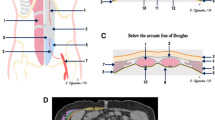Summary
Incisional hernias of the abdominal wall assume many clinical forms in terms of their site and size, the quality of the tissues of the abdominal wall and the number of previous recurrences, among many other factors. Any serious prospective and possibly comparative scientific study dealing with the results of treatment must begin by defining the type of incisional hernia studied. Hence, it seemed necessary to employ a classification allowing a study or comparison of homogeneous groups. The aim of this work was to propose a simple classification of predictive value, based on a statistical study of the relations between four parameters, i.e. the site of the incisional hernia, the width of the hernial orifice, the number of previous recurrences, and the results of treatment. A retrospective study dealing with a series of 435 abdominal incisional hernias was done to this end.
Similar content being viewed by others
References
Baggish MS, Lee WK (1975) Abdominal wall disruption. Obstet Gynecol 46: 530–534
Belcher HJ, Ellis H (1991) An investigation of the role of diet and burn injury on wound healing. Burns 17: 14–16
Bucknall TE (1983) Factors influencing wound complications: a clinical and experimental study. Ann Roy Coll Surg Engl 65: 71–78
Cameron AE, Parker ES, Gray RC, Wyatt AP (1987) A randomised comparison of poly-dioxanone (PDS) and polypropylene (Prolene) for abdominal wound closure. Ann R Coll Surg Engl 69: 113–115
Chevrel JP, Rath AM (1997) The use of fibrin glues in the surgical treatment of incisional hernias. Hernia 1: 9–14
Dostal GH, Gamelli RL (1990) The differential effect of corticosteroids on wound disruption strength in mice. Arch Surg 125: 636–640.
Ellis H (1976) Wound healing. Ann Roy Coll Surg Engl 59: 382–387
Gys T, Hubens A (1989) A prospective comparative clinical study between monofilament absorbable and non-absorbable sutures for abdominal wall closure. Acta Chir Belg 89: 265–270
Greenhalgh DG (1987) Is impaired wound healing caused by infection or nutritional depletion ? Surgery 102: 306–312
Hay JM, Boudet MJ, Fingerhut A, Pourcher J, Hennet H, Habib E, Veyrières M, Flamant Y, and The French Association for Surgical Research. (1995) Shouldice inguinal hernia repair in the male adult: the gold standard? A multicenter controlled trial in 1578 patients. Ann Surg 222: 719–727
Herzsage L. (1999) Indication and limitations of suture closure — Significance of relaxing incisions. In: V. Schumpelick, A. N. Kingsnorth Eds., Incisional Hernia, Springer-Verlag Berlin Heidelberg, pp 279–283
Israelsson LA, Jonsson T (1993) Suture length to wound length ratio and healing of midline laparotomy incisions. Br J Surg 80: 1284–1286.
Jonsson K, Jenseu JA, Goodson WH, Scheuenstuhl H, West J, Hopf HW, Hunt TK. (1991) Tissue oxygenation, anemia, and perfusion in relation to wound healing in surgical patients. Ann Surg 214: 605–613
Law NW, Ellis H (1990) The effect of parenteral nutrition on the healing of abdominal wall wounds and colonic anastomoses in protein-malnourished rats. Surgery 107: 449–454
Mäkelä JT, Kiviniemi H, Juvonen T, Laitinen S (1995) Factors influencing wound dehiscence after midline laparotomy. Am J Surg 170: 387–390
Makishima T (1989) Experimental study of the wound healing in liver cirrhosis. Nippon Geka Gakkai Zasshi 90: 1706–1712
Niggebrugge AH, Hansen BE, Trimbos JB, van de Velde CJH, Zwaveling A. (1995) Mechanical factors influencing the incidence of burst abdomen. Eur J Surg 161: 655–661
Regnard JF, Hay JM, Rea S, Fingerhut A, Flamant Y, Maillard JN (1988) Ventral incisional hernias: incidence, date of recurrence, localization and risk factors. Ital J Surg Sci 18(3): 259–265
Sanders RJ, DiClementi D (1977) Principles of abdominal wall closure. Arch Surg 112: 1188–1191
Schumpelick V, A. N. Kingsnorth et al (1999) Panel discussion: classification. In: V. Schumpelick, A. N. Kingsnorth Eds., Incisional Hernia, Springer-Verlag Berlin Heidelberg, pp 491
Schwartz D, Flamant R, Lellouch J. (1980) The problem of missing subjects. In: Clinical trials. London, Academic Press, pp 223–224
Smith M, Enquist IF (1967) A quantitative study of impaired healing resulting from infection. Surg Gynecol Obstet 125: 965–973
Soisson AP, Olt G, Soper JT, Berchuck A, Rodriguez G, Clarke-Pearson DL (1993) Prevention of superficial wound separation with subcutaneous retention sutures. Gynecol Oncol 51: 330–334
Author information
Authors and Affiliations
Rights and permissions
About this article
Cite this article
Chevrel, J.P., Rath, A.M. Classification of incisional hernias of the abdominal wall. Hernia 4, 7–11 (2000). https://doi.org/10.1007/BF01230581
Received:
Accepted:
Issue Date:
DOI: https://doi.org/10.1007/BF01230581




